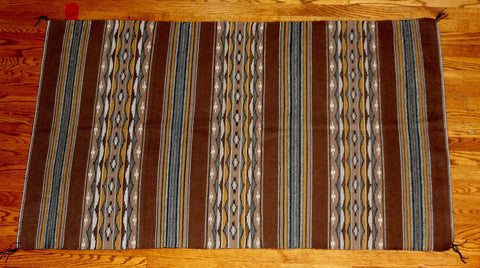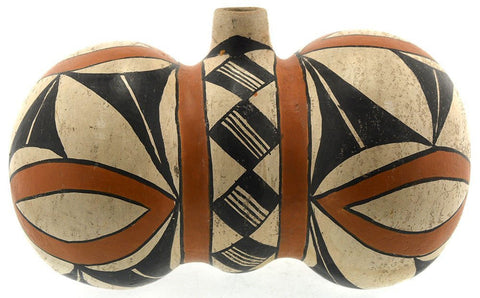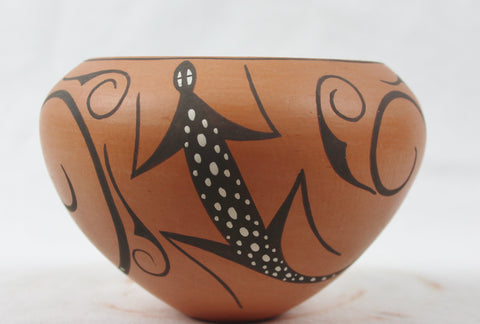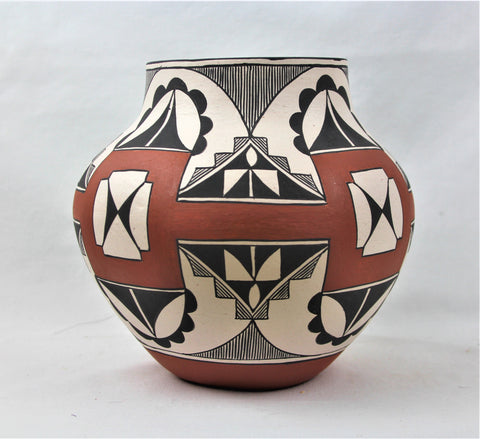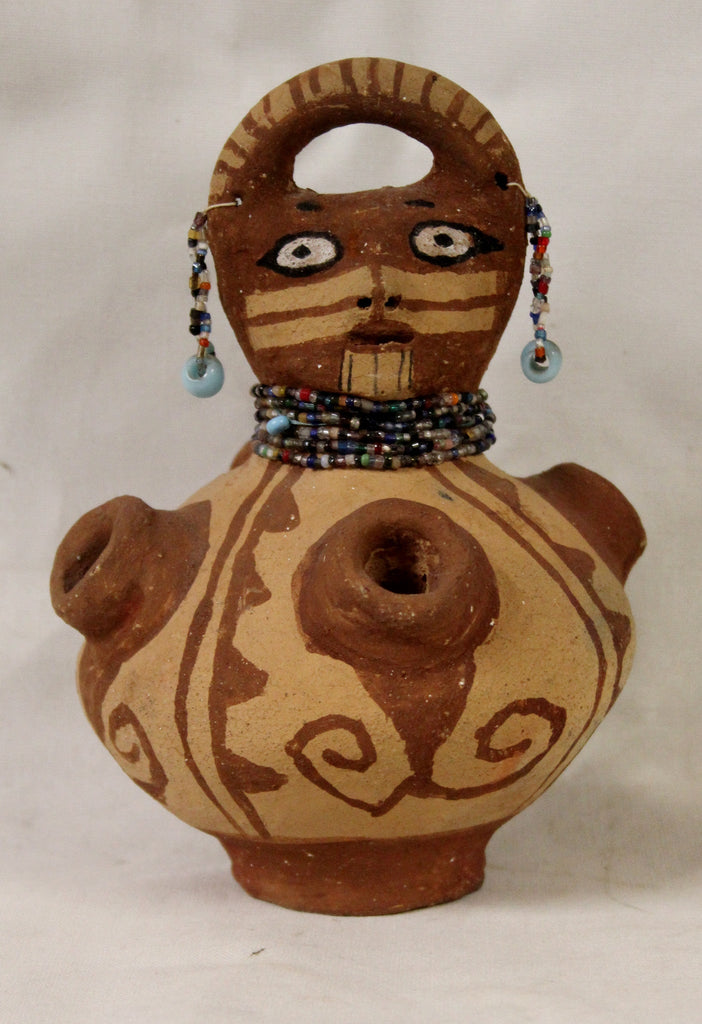
Native American Mohave Hand-Painted Pottery Effigy With Beaded Earrings and Necklaces, #931 SOLD
$ 577.00
Native American
Mohave Hand Painted Pottery Effigy
931. Description: Native American Mohave Hand Painted Pottery Effigy with beaded earrings and necklaces;
Dimensions: 6.5" x 4.5" x 4.5"; Approximate Weight: 1 lb.
Condition: Excellent for age
Provenance: The William Pierce Estate, Native American Collection, Scottsdale AZ.
In the late 19th century, Mohave potters began producing effigy vessels depicting traditional Mohave dress and self-decoration styles. These were sold to travelers at the train stations in Needles and Yuma, Arizona. Annie Fields of Needles was among the most well-known Mohave potters. She popularized this type of 4-spouted jar, embellished with glass beads. Mrs. Fields died in 1971. (Source: Arizona State Museum
Additional Information on Mojave Pottery follows:
“In the nineteenth and twentieth centuries, the Mojave, or aha macav ("people who live along the river") continued a long tradition of pottery-making, adapting to the new Euro-American tourist market. Gathering clay along the Colorado River in Southern California, Mojave craftswomen formed ceramic utilitarian vessels, human and animal effigies, and dolls. While these forms continue an older ceramic tradition, Mojave potters began to generate new artistic styles while incorporating new materials, such as trade cloth and commercial paint.
Considered a woman's art, Mojave craftswomen traditionally made ceramics during the dry season in a location outside of the home. Utilitarian pots for storage, cooking, and eating were generally plain or decorated with simple geometric designs in yellow ocher which turned red in the firing process. The advent of the tourist trade brought adaptations to these wares, such as the addition of handles to the pots. Unlike utilitarian ceramics, Mojave effigies and dolls were painted brightly, and were modeled from un-fired clay, making the figurines quite fragile.
Mojave women produced both human and animal effigies, in both figural and vessel form. Craftswomen also created clay dolls to sell to tourists, emphasizing the head, eyes, and large feet of the dolls, which allowed the figures to stand unaided. Male and female dolls were dressed traditionally and painted with different tattoo patterns to represent their gender. Male dolls wear cloth breech clouts while female dolls appear in cloth skirts. Both wear beaded necklaces and earrings, and horsehair for hair”. (Source: Portland Art Museum)
Mohave Hand Painted Pottery Effigy
931. Description: Native American Mohave Hand Painted Pottery Effigy with beaded earrings and necklaces;
Dimensions: 6.5" x 4.5" x 4.5"; Approximate Weight: 1 lb.
Condition: Excellent for age
Provenance: The William Pierce Estate, Native American Collection, Scottsdale AZ.
In the late 19th century, Mohave potters began producing effigy vessels depicting traditional Mohave dress and self-decoration styles. These were sold to travelers at the train stations in Needles and Yuma, Arizona. Annie Fields of Needles was among the most well-known Mohave potters. She popularized this type of 4-spouted jar, embellished with glass beads. Mrs. Fields died in 1971. (Source: Arizona State Museum
Additional Information on Mojave Pottery follows:
“In the nineteenth and twentieth centuries, the Mojave, or aha macav ("people who live along the river") continued a long tradition of pottery-making, adapting to the new Euro-American tourist market. Gathering clay along the Colorado River in Southern California, Mojave craftswomen formed ceramic utilitarian vessels, human and animal effigies, and dolls. While these forms continue an older ceramic tradition, Mojave potters began to generate new artistic styles while incorporating new materials, such as trade cloth and commercial paint.
Considered a woman's art, Mojave craftswomen traditionally made ceramics during the dry season in a location outside of the home. Utilitarian pots for storage, cooking, and eating were generally plain or decorated with simple geometric designs in yellow ocher which turned red in the firing process. The advent of the tourist trade brought adaptations to these wares, such as the addition of handles to the pots. Unlike utilitarian ceramics, Mojave effigies and dolls were painted brightly, and were modeled from un-fired clay, making the figurines quite fragile.
Mojave women produced both human and animal effigies, in both figural and vessel form. Craftswomen also created clay dolls to sell to tourists, emphasizing the head, eyes, and large feet of the dolls, which allowed the figures to stand unaided. Male and female dolls were dressed traditionally and painted with different tattoo patterns to represent their gender. Male dolls wear cloth breech clouts while female dolls appear in cloth skirts. Both wear beaded necklaces and earrings, and horsehair for hair”. (Source: Portland Art Museum)
Related Products
Sold out
Sold out
Sold out






